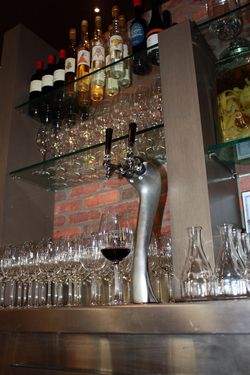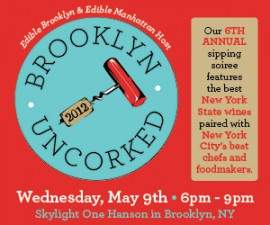Wine on Tap: Local Restaurant, Wineries Go Beyond Bag-in-Box

Verace, a newly opened Italian restaurant in Islip, NY with three local wines on tap.
By Lenn Thompson, Editor-in-Chief
Photos courtesy of Verace
I think we've all been there — in a restaurant that may or may not pay much attention to its wine list and may or may not pay even less attention to their by-the-glass selection — more or less offering whatever is already open, and over-charging you for it.
You order a glass anyway, knowing that you're playing by-the-glass roulette. Before you even take a sip, you can pinpoint how long the bottle has been open — somewhere between a week and a year. Oxidized, cooked or both.
Now imagine a different world completely, one where every glass of wine is fresh and tastes the way the winemaker intended. Now imagine that — in that same world — the wine by the glass isn't a rip-off.
 This is the world of wine in kegs. And it's come to Long Island in the form of Verace, a new Italian restaurant in Islip. I haven't been there yet, but the wine program is certainly intriguing.
This is the world of wine in kegs. And it's come to Long Island in the form of Verace, a new Italian restaurant in Islip. I haven't been there yet, but the wine program is certainly intriguing.
Sure, they have a 'regular' wine list — which, as you'd expect, is heavy on Italian wines. That makes sense and isn't anything special. But the cool thing is the four wines that they have on tap. There is an Italian-made Barbera, but what got the attention of this local wine entusiast is the other three taps.
There's a dry riesling from Hermann J. Wiemer up on Seneca Lake and two wines made at Raphael on the North Fork — a steel-fermented sauvignon blanc and a custom-made blend of 68% merlot (clone 181), 19% cabernet franc aged in old wood, 8% malbec
and 5% petit verdot.
Because these wines were gravity fed — unfined and unfiltered — directly into kegs under nitrogen gas right at the winery and are held under pressure until being poured, they aren't exposed to oxygen or sunlight, two of wine's great enemies. Think of these kegs as bag-in-box wines on steroids, with much higher-quality wine in them.
Not surprisingly, the inspiration for the system comes from the Old World — Italy to be more precise. Verace co-owner Michael Bohlsen told me in an email that “We stopped at a small restaurant on the side of the road and drank some wonderful red wine from a pitcher. I asked where the wine was from. The owner pointed out the window to the vines in plain sight.”
That’s the Italian wine experience that he wanted to bring to Long Island.
He's done it and according to Raphael winemaker Rich Olsen-Harbich "There has never been a fresher wine served on
Long Island."
Consistently fresh wine in your glass is an obvious benefit to consumers, but look just a bit deeper and there are benefits for the restaurant, the winery and the environment too. “I like not having to order extra glass and cardboard. It makes our entire winery just a little more environmentally friendly which I'm proud of," Olsen-Harbich told me.
With its wine-in-keg system, Verace has been able to reduce its carbon footprint and save money too. It doesn’t have to pay for the waste associated with bottling or for shipping bottles across the country or around the globe. They don't have to dispose of the empty bottles or the cardboard boxes they come in.
“The price of the wine reflects those savings,” Bohlsen said.
They also never worry about corked bottles or pouring wine from bottles that have been open too long — again, eliminating waste. “It is just a more efficient, higher-quality product with the benefit of being kind to the environment," Bohlsen said.
For someone like Olsen-Harbich who has been making wine on Long Island for nearly 30 years, this has been a fun project to be a part of. "The development of a wine to match the (restaurant's) cuisine is very cool. I usually don't get a chance to do that, so it was great to have this completely involved process with everyone participating."
He's not kidding when he says "everyone." He met with the entire restaurant staff, including
head chef Francesco Torre to taste through two dozen lots of reds from
the 2008 vintage. "It was
great to sit and work with a group of people who were obviously all in
love with what they are doing and all had great palates."
Olsen-Harbich describes the finished blend as "beautifully aromatic and soft yet with an
authentic rustic edge. Completely ready to drink today with enough
complexity to be really alluring. It's the perfect wine for Francesco's
food."
But, the most important thing to Olsen-Harbich is that "People can enjoy my wine in a new way. Wine has been available in larger, refillable vessels in Europe for a long time, so its nice to see this philosophy take root here. The people of Long Island live close to a great wine region and enjoying local wine in this way is a benefit of living here — its the way it was supposed to be!"
From the sounds of it, Olsen-Harbich is far from the only one so excited and enthusiastic about the program.
"We expected to have quite a bit of resistance," Bohlsen told me, referring to his customers. "On the contrary, the program has been widely embraced. People
are curious as to how we got it done. They are truly amazed at how
wonderful the wine really tastes. And, of course, the affordable price
is attractive."
















Very cool!
That is so very cool! Love this idea. More restaurants should take their lead and get those local wines up front on their lists.
This is a great idea and it’s nice to see a place that embraces local production like that.
Okay, so how do you do this legally, as a winery? You can’t sell wine without a label, and every label has to be approved the the TTB ahead of time. Do you get a label approval for each keg?
We’ve had requests before to sell bulk wine (granted, they were al lthe poeple without any license at all, but still), but I didn’t know how to do it legally, so we didn’t. Enquiring minds ant to know . . .
Labels have to be TTB approved for 5.1 gallons for each wine just like a bottle. Every winery have to submit their label for each specifically wine.
Do you have any good juice to sell? As long as you run a legaly bounded winery you can buy juice and repackage in any TTB approved vessel.
Believe me we have worked on this for almost two years and finnaly got it done thanks to the support of local wineries.
Paulo Villela
In 5 years or less wine on tap will be commonplace. It’s time has come.
Paulo,
Thanks, that’s great to know. It was the obvious answer, but not one I had considered.
I take it you’re with Verace? Would you have any interest in serving a dessert wine (maybe a Riesling Icewine) this way? If so, please contact me at Sheldrake Point. Thanks!
Kareem: I hope you’re right. Heck, I can think of worse things than having a quarter keg of Paumanok Chenin Blanc on tap at all times at my house.
Wow…we’ve done this for years at Catharine Valley Winery. We use it for glass shows and weddings. Sounds like I need a special container to sell it to restaurants or bars.
I am the winemaker at Wooldridge Creek Winery in Southern Oregon. We have been placing our wines in kegs for restaurants since June of 2009. At this point, our accounts have poured more than 25,000 glasses from kegs. We know this works. If anyone has any questions, I’ll be happy to share. We have learned a lot about how to make this work for everyone. Cheers, Greg.
City Winery in NYC has had an active multi-tap system since they opened, they seem to rotate new wines through fairly often, pouring a pinot noir rose at the moment….fresh and fast.
http://www.citywinery.com
We are implementing a wine on tap and bottle refilling operation at Bottleshop, the wine bar above our urban winery in Seattle. http://www.wilridgewinery.com